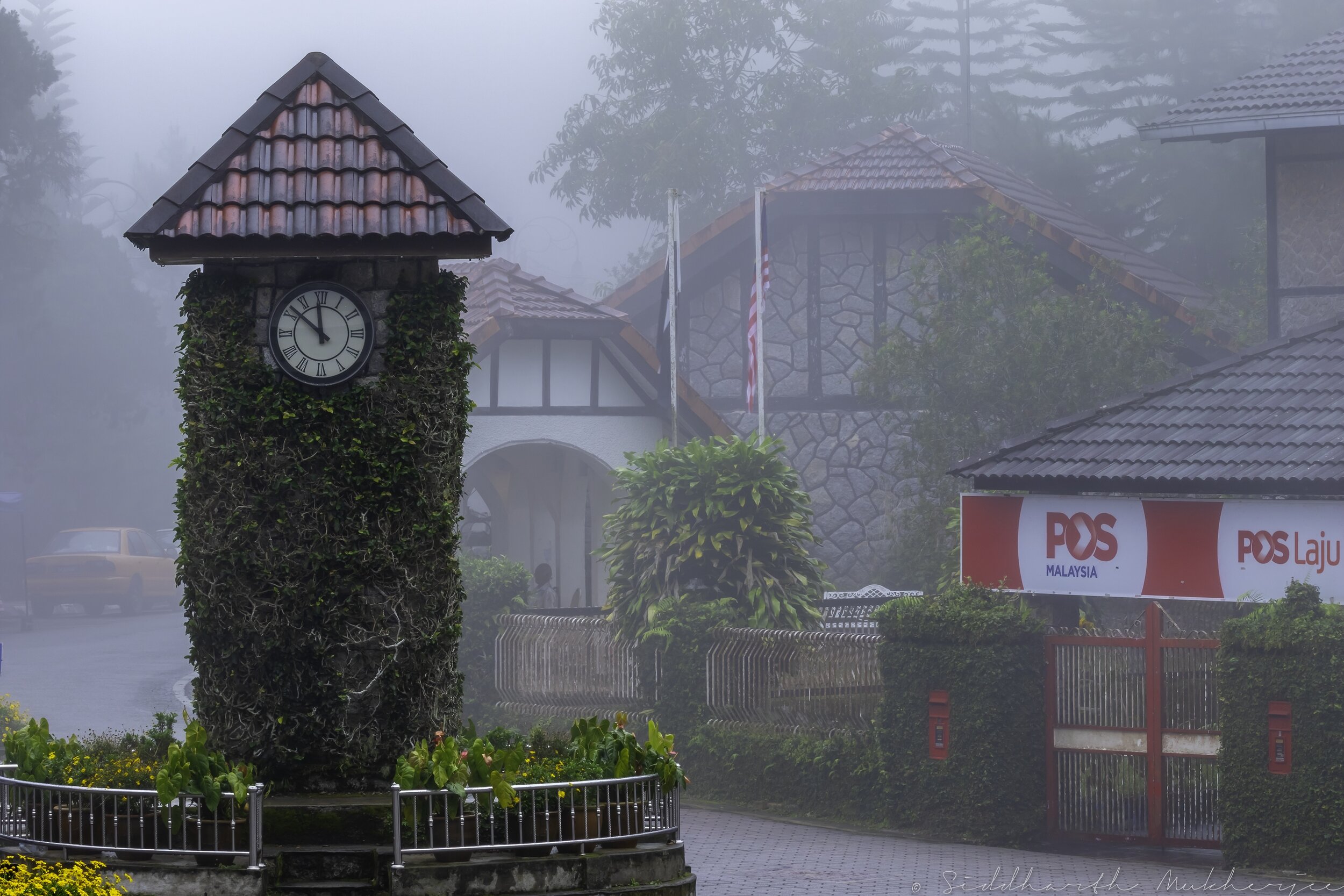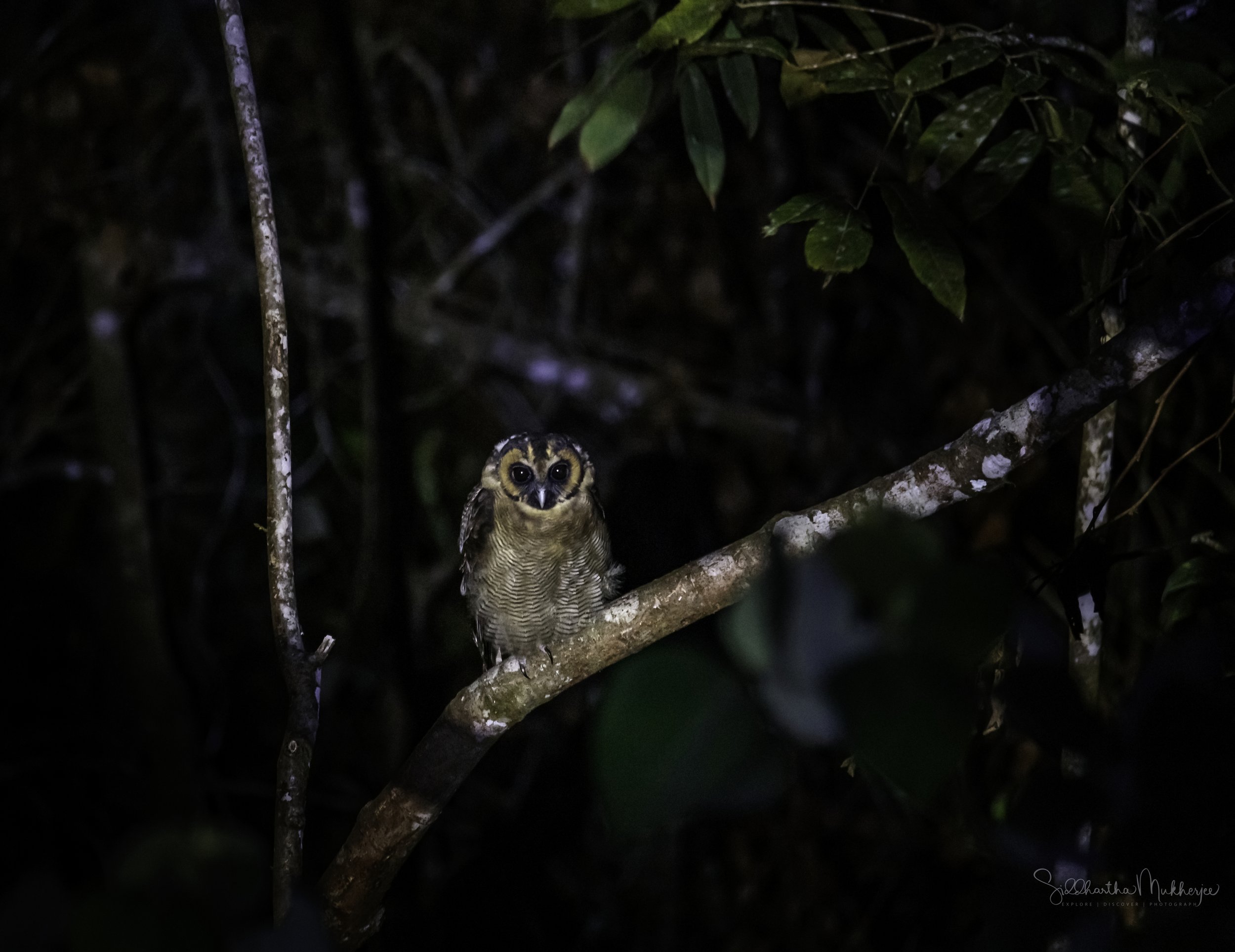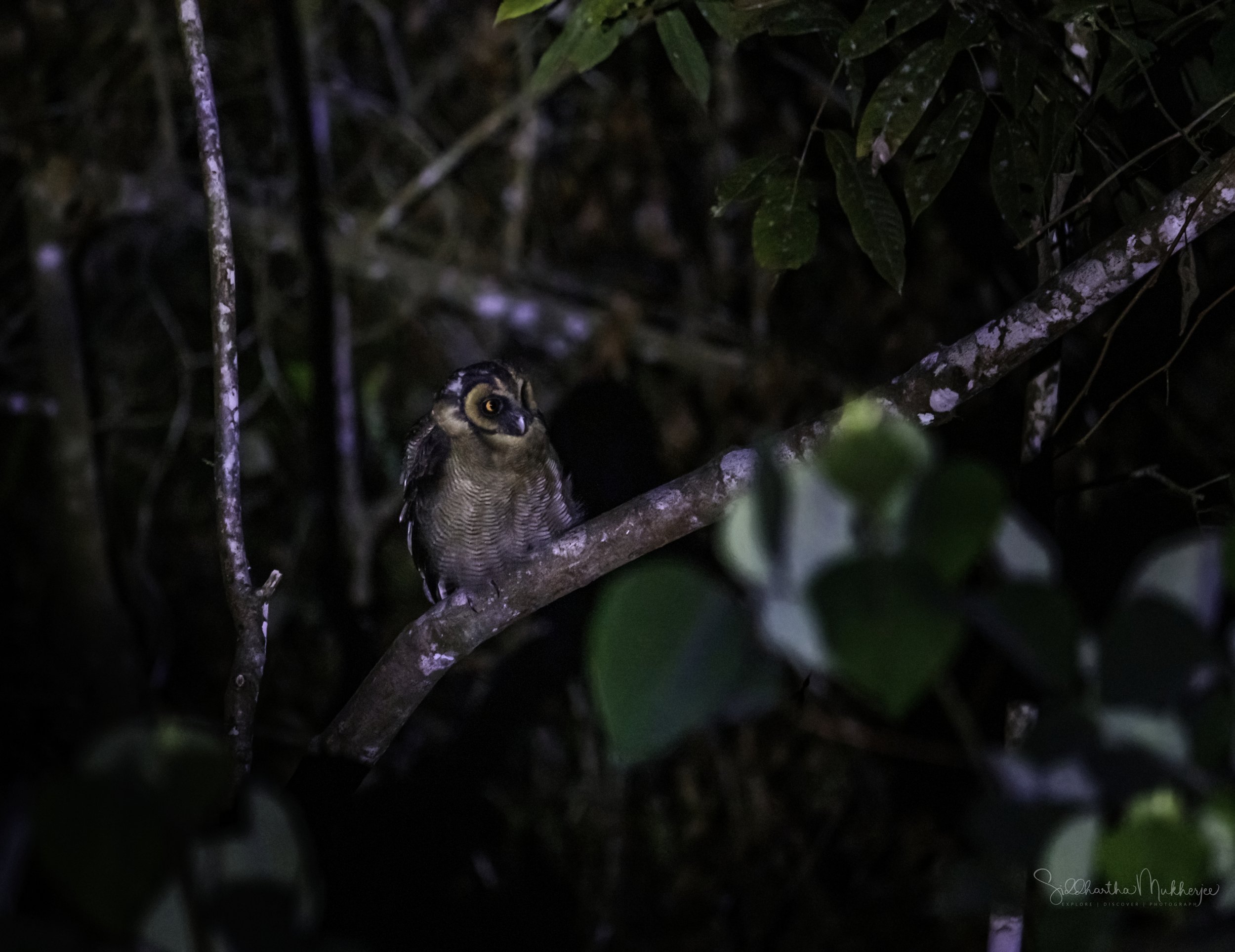Brown Wood Owl
Strix leptogrammica
Bukit Fraser, Malaysia
I love Fraser’s Hill! A leisurely 99 kilometers drive from Kuala Lumpur, Fraser’s Hill is cool, uncomplicated and quiet. It also has 7 terrific trails that are suitable for trekking and birding. Located in the highlands of the Titiwangsa range, many visitors to Fraser’s Hill come for the cooler climes that attracted the British administration to transform this 19th century mining outpost into a hill station some 100 years ago. Others come for its quaint English charm and colonial architecture. Compared with that other former colonial hill station, Cameron Highlands, Fraser’s Hill has not been ravaged by mass tourism and unchecked development, and its forests, which are home to indigenous and endemic species, have not been felled for illegal farm lands. In fact, concerned about this, the Pahang government undertook to freeze development of its virgin forests in 2010, though vigilance remains essential.
This picturesque highland village is famous for its montane rainforest and extensive biodiversity. Over 400 species of birds have been recorded in the surrounding area. The Hemnant and Bishop trails are the most popular forest trails amongst birders, although Telekom loop has proven to provide the most consistent and productive birding, and its diverse mixed flocks, superior accessibility and well-lit clearings offer a plethora of exciting and unique photography opportunities. The diversity of flora and fauna varies rapidly with changes in altitude, and lower elevation birding at The Gap and Jeriau Waterfall offers additional specialty species not found in the higher elevation cloud forest. Bird feeders at the Shahzan Inn always attract attention, and a hidden feeding station at the abandoned Jelai Highland Resort offers photographers the opportunity to get up close and intimate with species that wouldn't otherwise show well. Travelling to Fraser's hill requires a car, as other transport options are limited; although several companies offer guided tours if renting a car isn't possible. There are two one-way roads, each designated to either ascend or descend, which function as a loop to coordinate traffic up and down the hill.
Over time Fraser’s Hill’s popularity has waxed and waned, but it’s on an uptick right now. Weekends see a deluge of birders, hikers, cyclists, super bikers and families, yet as a day trip or weekend destination it remains pleasantly unencumbered. One reason for this is its walkability. The lack of heavy traffic, its compactness and connectability, and its fresh mountain air and abundant tree shade makes Fraser’s Hill a joy to explore on foot. It also has a variety of short trails that cut through its forests. Off these trails my favourite is the popular Bishop’s Trail.
The trail is named after Reverend CJ Ferguson-Davie from Singapore, who rediscovered Fraser's Hill in 1917 while looking for his friend - the original founder Louis James Fraser who had gone missing circa 1915. Ferguson and a fellow bishop failed to find any trace of Fraser, but they did recommend the area for development as a hill resort, which the British government took heed. Ferguson himself was given a piece of land where he built a quaint cottage and called 'The Retreat'. Later, he opened a trail from his cottage that led to neighbouring bungalows Muar and Cicely; this later became Bishop trail in present day. Bishop’s Trail is a 3.4-km loop trail generally considered a moderately challenging route, it takes an average of 1 h 33 min to complete. This is a very popular area for birding, hiking, and running, so you'll likely encounter other people while exploring. The trail is open year-round and is beautiful to visit anytime.
From a birding perspective there are records of about 400 species inhabiting the entire area and it is dependent on your luck and time of year what you can see. You can see some of the species I have been fortunate to record here in my numerous trips. This is by no means a complete list and only the ones I have been able to put on my blogs. There are quite a few more I am yet to write about.
Today is about a large, solemn-looking brown owl with deep black eyes belonging to the earless owl genus Strix. It varies in plumage throughout its extensive range but always has a dark-bordered pale face, fine barring on its wings and underparts, and sooty areas around the eyes. It inhabits lowland and montane broadleaf forests and adjacent edges and gives a short burst of loud, reverberating hoots.
The brown wood owl is found in India, Bangladesh, Sri Lanka, Indonesia, Taiwan, and south China and is a resident breeder in south Asia. This species is a part of the family of owls known as typical owls, which contains most species of owl. I was able to spot this owl in the complete darkness thanks to a US Marine who lent me his excellent thermal monocular - the Pulsar Axion 2 XG35 - I think it was. Had it not been for him, who incidentally was out with his wife for a post dinner walk, we’d have been standing there for much much longer and in all likelihood staring in the wrong direction.


Brown Wood Owl
Shooting in complete darkness - zero dark thirty - thanks to the kind stranger with a thermal scope to spot, and some more with flashlights to help reduce some noise - the photos in this series vary from ISO 12800 to ISO 2500.
The Brown Wood Owl (Strix leptogrammica) is found in India, Bangladesh, Sri Lanka, Indonesia, Taiwan, and south China and is a resident breeder in south Asia. This species is a part of the family of owls known as typical owls (Strigidae), which contains most species of owl. It belongs to the earless owl genus Strix.
The Brown Wood Owl is medium large (45–57 cm), with upperparts uniformly dark brown with faint white spotting on the shoulders. The underparts are buff with brown streaking. The facial disc is brown or rufous, edged with white and without concentric barring, and the eyes are dark brown. There is a white neckband. The sexes are similar in appearance.
Their call is a (hoo) hoo hoo HOO, or a deep goke-goke-ga-LOOO, or a loud scream. Their alarm call is a bark, wow-wow. Some subspecies are known to produce distinct vocalizations; they are also different in appearance and parapatric, and might be distinct species: The northern Strix (leptogrammica) newarensis group (Himalayan wood-owl; present subspecies newarensis, ticehursti, laotiana and caligata) which occur from the Himalayan foothills of Kashmir east to Taiwan have a soft low to-hooh not unlike a rock dove cooing. S. (l.) bartelsi (Bartels's wood-owl), Javan wood-owl from Java, the south eastern most taxon, has a loud, forceful, single HOOH! with long pauses between calls.
This species is highly nocturnal and is commonly found in dense forests. It can often be located by the small birds that mob it while it is roosting in a tree. The diet of the brown wood owl consists mainly of small mammals, birds, and reptiles.
The Brown Wood Owl is about 39–55 cm long and weighs between 800–1100 g (nominal), 500–700 g (bartelsi), 970 g (newarensis). It has a whitish to pale rufous-brown facial disc with broad black eye ring; whitish eyebrows, occasionally with a rufous tinge and the crown is dark brown. The upperparts are a paler chestnut brown, with some white or paler bars on the scapulars, wings, and tail. The chin is dark brown while the throat and underparts are white to buff, the breast is often brown, all with fine indistinct brown barring and the tarsus fully feathered; the iridians are dark brown; the cere a bluish grey; bill greenish; toes bluish grey to pale plumbeous. The juvenile is light rufous, barred rufous, with wings darker with dark rufous bars, underparts a pale buff with faint barring. Races vary in size, depth of colouration and markings: indranee, ochrogenys and maingayi are a deeper, darker brown, with a dark rufous facial disc and more chestnut in ochrogenys. Vaga is slightly larger than the nominate and duller and more greyish while niasensis is smaller, brighter with a chestnut breast. The species bartelsi differs with more fawn on the facial disc, dark brown above and. a pale chin. "Gruponewarensis" is much larger and whitish to pale fulvine-brown facial disc, large white throat patch, brown breast band, but within this group subspecific differences are mainly around size, with laotian (wing 377-442 mm) slightly darker above, particularly on the head, and buffier below than newarensis (wing 395-442 mm), while ticehursti (wing 355-395 mm) and caligata (wing 367-401 mm) are both smaller to a greater or lesser extent.
The following subspecies are recognised:
Brown Wood-Owl (Brown)
Strix leptogrammica [indranee Group]
Strix leptogrammica indranee: Distributed in Peninsular India
Strix leptogrammica ochrogenys: Distributed in Sri Lanka
Strix leptogrammica newarensis: Distributed in the Himalayas, from eastern Jammu and Kashmir to northeastern India.
Strix leptogrammica ticehursti: Distributed in Northern and central Myanmar, eastern to southern China (northeast to Anhui), southern to northern and western Thailand, northern Laos, and northern Vietnam.
Strix leptogrammica maingayi: Distributed in Hainan and Taiwan.
Strix leptogrammica caligata: Distributed in Hainan and Taiwan.
Strix leptogrammica laotiana: Distributed in S Laos, C Vietnam (Annam), EE Thailand and Cambodia.
Brown Wood-Owl (Nias)
Strix leptogrammica niasensis: Distributed in Nias I, off western Sumatra.
Brown Wood-Owl (Bornean)
Strix leptogrammica [leptogrammica Group]
Strix leptogrammica nyctiphasma: Distributed on Banyak Island, off western Sumatra.
Strix leptogrammica myrtha: Distributed in Sumatra; also reported (presumably this race) from the Mentawai Islands, off western Sumatra.
Strix leptogrammica vaga: Distributed in Northern Borneo.
Strix leptogrammica leptogrammica: Distributed in Central and Southern Borneo.
Strix leptogrammica chaseni: Distributed in Belitung I, off southern Sumatra.
Strix leptogrammica bartelsi: Distributed in Java
Their preferred habitat is forest, usually dense and undisturbed, generally avoiding areas of human habitation. In the northern Indian subcontinent, often moist evergreen and deciduous, usually at 750–2500 m, but also reported up to 4000 m; dense, leafy forest at 760–2700 m in Nepal; up to 2750 m in China and Taiwan; plains up to 1800 m in peninsular India, also densely wooded gardens in Sri Lanka; observed in both montane forest and open country in Thailand; primary forest in lowland Borneo and Sumatra, where it has been recorded up to 1500 m; undisturbed montane forest and forest edge in Java.
Their diet includes small mammals, mostly rodents but also some shrews, and one Javan specimen contained fruit bat (Cynopterus) remains in the stomach; also small birds and reptiles, and large insects; some reported as captured fish. The apparently most important birds of prey in the northern part of its range include not only smaller species such as pigeons and mynas but also some up to the size of pheasants; a clear preference for partridges (Arborophila, Bambusicola).
From a vocalization standpoint they give a short series of 3-4 short hoots, the first very soft, the last longer and louder; also deep, four-syllable "goke-goke-ga-looo" with emphasis on the final note; barking "wow wow" alarm call also observed. Breed bartelsi a distinctive, loud, explosive, forceful, single "hooh", repeated at long intervals; "gruponewarensis" a low "to-hooh" not unlike the rock pigeon (Columba livia).
It is not globally threatened and is classified as Least Concern. CITES II. It is uncommon throughout most of its range in the Indian subcontinent, and rare and local in Bangladesh; possibly more common, or locally common, in Sri Lanka; rare in Java, where ongoing logging of montane forests is a major threat; elsewhere in its range it appears to be uncommon to rare, again suffering from forest destruction. The global population size and trends are unknown. It is present in several protected areas throughout its range, including Chitwan National Park (Nepal), Nam Nao National Park and Khao Nor Chuchi Wildlife Sanctuary (Thailand), Way Kambas National Park (Sumatra), Gunung Mulu National Park (Sarawak), Danum Valley Protected Area (Sabah), Barito Ulu National Park (Kalimantan), and Baluran National Park (Java).
The following gallery of the Brown Wood Owl is from the single instance I have spotted this at Bukit Fraser in the vicinity of Bishop’s Trail.
‡‡‡‡‡
Related Posts












